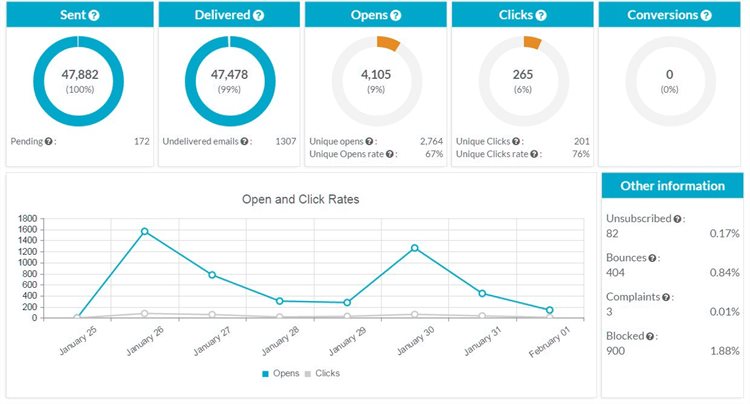Email Marketing...When is it too Much?
Today, I’m diving into the question that most email marketers are asking themselves more often than not – How often should I be emailing my subscribers?
Unfortunately, there’s no perfect answer for this, but luckily, email marketing provides you with the insights and tools you need to answer those questions yourself.
There is one thing for certain, to gain key metrics you will need to perform a few tests, you can make sure you’re sending the right amount of emails by following and tracking the most important metrics below:
-
Open Rate
-
Click Through Rate
-
Conversion Rate
-
Unsubscribe Rate
-
Bounce Rate

Open Rate
The open rate is simply the average number of opened emails divided by the number of subscribers you sent that email to. So for example, a 20% open rate would mean that for every 10 emails delivered to an inbox, two were actually opened. It’s not surprising that most email marketers want to know if their subscribers are actually opening their emails. If you’ve sent a recipient a message at the right time with a subject line that speaks to them about a need they might have, chances are they are going to open it – It’s that simple.
Click Through Rate
The click through rate is the percentage of people visiting a web page who have accessed a link from a particular advertisement. Unlike the open rate, most marketers will agree that click-through rates are a key indicator of email marketing performance. One very important example is ensuring your design is mobile friendly. More then 60% of emails that are opened are on a mobile device so it’s important to think about the email marketing experience by putting yourself in the recipient's shoes – this way you are experiencing what your recipients are experiencing.
Conversion Rate
Getting your audience to open your campaigns, click on your links and how many of them purchased an item or downloaded your content is your conversion rate. Consider conversion rate optimization – this is the percentage of subscribers who say, completed a desired call to action whether it’s a form, button or link to a landing page. This is something that should be eye catching and attract the reader's attention to make them want to click it. CRO is defined by Smashing Magazine as: “the process of improving the way a user interacts with a website to increase the chance that they will convert. Many factors affect conversion rates, from layout to color choice.”
Unsubscribe Rate
The Unsubscribe Rate are recipients who clicked on the unsubscribe link (the link is typically added at the top or at the bottom of your newsletters or marketing campaigns). Recipients who unsubscribe aren't always a good thing but they’re also not always bad. If this rate is high, you may want to reach out to these subscribers with a survey or possibly do some A/B testing. Any feedback may be good information to take into consideration.
Bounce Rate
The Bounce Rate indicates invalid or not-existant email addresses and temporary errors. If you have a high bounce rate, it’s time to update your information. Confirmed opt-in is one of the many ways you can help assure data quality across all of your subscribe forms. By ensuring that people must activate their subscription with a confirmation email, any erroneous or inactive addresses simply won’t make it onto your active subscriber list. This can greatly reduce potential bounces, and lists using confirmed opt-in tend to be more engaged and active too.
Choosing the best frequency or days for sending emails is sometimes the biggest challenge since we are typically looking to maximize response, but want to avoid “over-mailing” since it can lead to unacceptable levels of unsubscribes and an increase in inactive subscribers – to a point where your audience may feel that they are being spammed. Even if they don't unsubscribe they will become "emotionally unsubscribed" as we may call it.
On the other hand, if you are “under-mailing” you are potentially losing the opportunity to gain a prospective proposition or get your promotions in front of the right subscribers and this could lead to loss of engagement or far worse, the loss of sales. If you're not showing enough of a digital presence in your consumers' eyes, it leaves room for other brands to engage them in their own conversation.
Here’s a study by MailChimp showing the optimal days to send your emails. Take this information as a guideline to start sending out your promotional emails and your newsletters.

Generally, 99% of businesses will fall into one of three categories when it comes to sending emails:
-
Emailing daily
-
Emailing frequently (1-3 times per week)
-
Emailing sporadically
They also say that 84% of consumers find less than half the emails they receive to be ‘relevant or interesting’. You also risk marketing to one of the 19 million ‘ghost’ email accounts which is an email account a consumer has abandoned as a result of irrelevant marketing, according to the DMA’s Consumer email tracking study.
It’s also important to note what type of lists you are emailing. If it’s a general list, then those numbers work. However if the community is smaller and more specific, your emails rate would be much higher, and if they are not you need to work on grabbing their attention.
Ending Notes
There are generally a couple companies who I look out for in my inbox because they typically try to sway me into coming back, like offering me enticing offers or promotions – do I always follow through with them? - No, but they always grab my attention. For instance, I haven’t reloaded my Starbucks app in quite some time but they’ve been emailing me constantly so I gave in one day and reloaded my app because they sent me a special offer that I couldn’t resist.
However, if I could choose a brand to award a stellar email marketing award to, one that always sticks out in my mind is Sephora. For great email marketing, and marketing in general, for me it's always in the attention to detail. I find their emails timely, their campaigns cohesive and relevant yet always diverse but most importantly, the customer journey I am taken on once I click into an item or rather, the path to purchase I embark on is always seamless. Its email marketing that doesn't feel like email marketing, just great product news and recommendations slipped into my digital sphere.
By taking a step back and reviewing your email marketing strategy and approach, you can establish what your subscribers want to receive from you. Getting the right frequency (of how often you email your subscribers) is no longer a concern when you’re consistently sending relevant and useful emails to your subscribers. Sending emails that your subscriber’s value will drive better results.

Gabriella Pirrone
Gabriella is the Digital Marketing Assistant for CMSC Media. She brings a wealth of knowledge from not only a CMS perspective but also content, SEO and eCommerce. She enjoys everything social media and staying ontop of the latest trends in the digital marketing world.